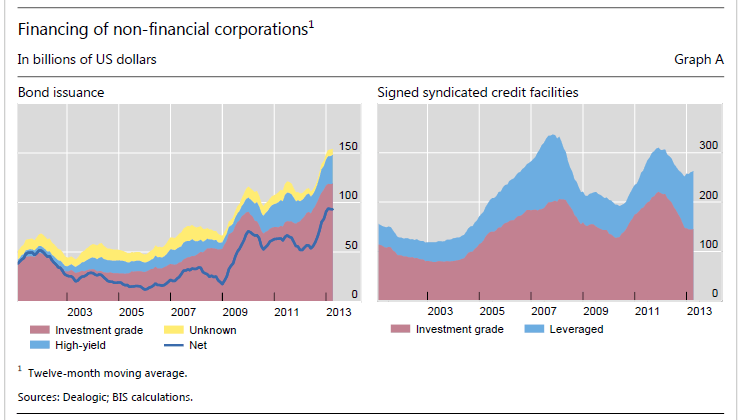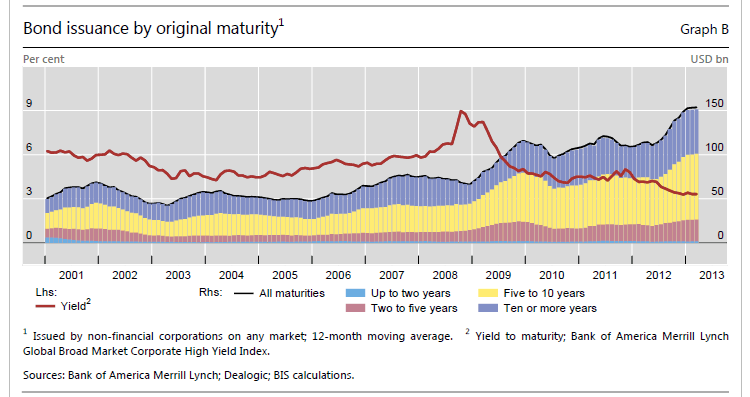Have corporations used low interest rates to lock in cheap funding?
(Extract from pages 21-22 of BIS Quarterly Review, June 2013)
Non-financial firms significantly stepped up their bond issuance after the global financial crisis. Net sales of bonds and notes by non-financial corporations increased from an average of under $30 billion per year between 2001 and 2006 to almost $70 billion in 2010-12 (Graph A, blue line in the left-hand panel).1 At the end of March 2013, 12-month cumulative net issuance fell just short of $100 billion, the highest level on record. A significant proportion of non-financial corporate issuance is by firms below investment grade. In the 12 months to end-March 2013, firms rated BBB- or below raised $29 billion (gross) in the bond market (Graph A, shaded areas in left-hand panel), or 19% of total non-financial corporate gross issuance. In absolute amount this is the most ever, but in relative terms it falls short of the 25% share taken by high-yield debt in late 2006-early 2007 and the 23% in early 2011.
The surge in non-financial issuance mirrored a decline in financial issuance. Net sales of bonds and notes by financial institutions worldwide peaked at just over $400 billion in the 12 months ending in May 2006 and then fell to a range of $150-200 billion annually between 2008 and 2012. In the 12 months up to March 2013, net issuance by financial institutions stood at a mere $32 billion, the lowest level in more than a decade.
The rise in bond issuance by non-financial companies during and shortly after the financial crisis was, at least in part, a reaction to the reduced availability of bank finance, but this factor appears to have lessened in importance more recently. Syndicated lending, a close substitute for bond issuance, contracted sharply in 2008 and 2009 but began to increase again in late 2010 (Graph A, right-hand panel). The number of newly signed facilities peaked in late 2011, but the continued growth in lending to lower-rated firms suggests that this is likely to be the result of lower demand for such funding by investment grade corporates rather than a lower supply of funds.
Although firms borrowing in the syndicated loan market tend to be smaller than firms issuing corporate bonds, there is some overlap between the two markets. Hence, a possible reason for the shift from syndicated lending to bond issuance could be that firms are taking advantage of low interest rates to lock in favourable funding conditions. Corporate bond yields shot up during the crisis but quickly fell back to unprecedentedly low levels (Graph B). Syndicated loans tend to pay floating rates, whereas coupons on corporate bonds are mostly fixed, allowing issuers to lock in low rates. The bulk of non-financial issuance was long-term, which is in line with this hypothesis. Well over one third of all bonds issued in 2010 and thereafter carried original maturities of 10 years or more, and almost one half had maturities from five to 10 years. That said, this maturity distribution is by no means unusual, and the proportion of very long-term corporate bonds is actually lower than it was in the years shortly before the crisis, when it fluctuated around 40%. This gives only partial support to the hypothesis that the nonfinancial corporate sector has taken advantage of the low interest rates to lock in cheap long-term funding.
1Data on volumes cover both international and domestic issues syndicated by international banks.


